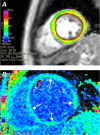Cardiac magnetic resonance imaging for the investigation of cardiovascular disorders. Part 2: emerging applications
- PMID: 24808772
- PMCID: PMC4004500
- DOI: 10.14503/THIJ-14-4172
Cardiac magnetic resonance imaging for the investigation of cardiovascular disorders. Part 2: emerging applications
Abstract
Cardiac magnetic resonance imaging has emerged as a robust noninvasive technique for the investigation of cardiovascular disorders. The coming-of-age of cardiac magnetic resonance-and especially its widening span of applications-has generated both excitement and uncertainty in regard to its potential clinical use and its role vis-à-vis conventional imaging techniques. The purpose of this evidence-based review is to discuss some of these issues by highlighting the current (Part 1, previously published) and emerging (Part 2) applications of cardiac magnetic resonance. Familiarity with the versatile uses of cardiac magnetic resonance will facilitate its wider clinical acceptance for improving the management of patients with cardiovascular disorders.
Keywords: Cardiomyopathies/diagnosis; fibrosis; gadolinium DTPA/diagnostic use; hypertrophy, left ventricular/diagnosis; magnetic resonance angiography; magnetic resonance imaging/standards; myocarditis/diagnosis; pericarditis, constrictive/diagnosis; sarcoidosis; stroke volume; ventricular dysfunction, left/diagnosis.
Figures






References
-
- Messroghli DR, Walters K, Plein S, Sparrow P, Friedrich MG, Ridgway JP, Sivananthan MU. Myocardial T1 mapping: application to patients with acute and chronic myocardial infarction. Magn Reson Med. 2007;58(1):34–40. - PubMed
-
- Messroghli DR, Radjenovic A, Kozerke S, Higgins DM, Sivananthan MU, Ridgway JP. Modified Look-Locker inversion recovery (MOLLI) for high-resolution T1 mapping of the heart. Magn Reson Med. 2004;52(1):141–6. - PubMed
-
- Goenka AH, Das CJ, Sharma R. Nephrogenic systemic fibrosis: a review of the new conundrum. Natl Med J India. 2009;22(6):302–6. - PubMed
Publication types
MeSH terms
LinkOut - more resources
Full Text Sources
Other Literature Sources
Medical

